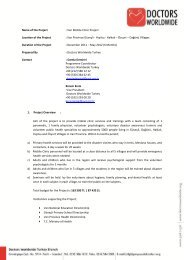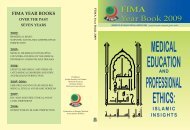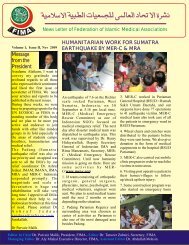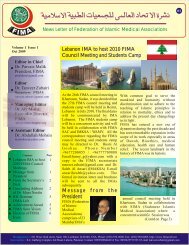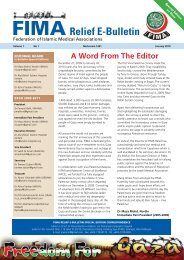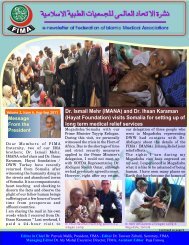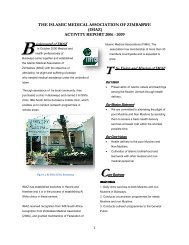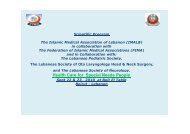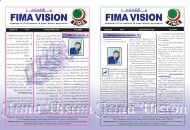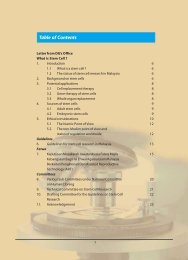FIMA Year Book 2010-2011 - Federation of Islamic Medical ...
FIMA Year Book 2010-2011 - Federation of Islamic Medical ...
FIMA Year Book 2010-2011 - Federation of Islamic Medical ...
You also want an ePaper? Increase the reach of your titles
YUMPU automatically turns print PDFs into web optimized ePapers that Google loves.
<strong>FIMA</strong> GIVES VISION<br />
(corrected visual acuity less than 3/60 in the<br />
better eye), based on WHO criteria. The rates <strong>of</strong><br />
blindness, visual impairment and low vision<br />
were 1.1%, 5.9% and 4.8% respectively.<br />
The distribution <strong>of</strong> VI by age group is 7% in the<br />
0-14 years age group, 28% in the 15-49 years<br />
age group, and 65% in the 50 years and older<br />
age group.<br />
Sri Lanka, being a developing South East Asian<br />
nation, has its own share <strong>of</strong> this disease burden.<br />
While the public sector eye care services are<br />
extremely limited and far from meeting the<br />
demands <strong>of</strong> the public, the cost <strong>of</strong> care in the<br />
private sector is prohibitive to many affected<br />
patients. It is indeed the humanitarian sector that<br />
frequently comes forward to help poor patients<br />
and ease the disease burden <strong>of</strong> the society in Sri<br />
Lanka and other developing countries.<br />
Status <strong>of</strong> Eye Health Care in Sri Lanka:<br />
Sri Lanka is a beautiful small island at the<br />
southern tip <strong>of</strong> South Asia. It has a population <strong>of</strong><br />
19.2 million. (50.2% female and 49.8% male). It<br />
has a higher literacy rate and life expectancy rate<br />
when compared to other neighbouring South<br />
Asian countries. Life expectancy at birth is 71<br />
years for male and 74 years for females 3 .<br />
The Kandy Eye Study, is a population based<br />
survey conducted in the Kandy district <strong>of</strong> Sri<br />
Lanka’s central province 4 . In this study <strong>of</strong> 1721<br />
eligible subjects, 1375 participated (79.9%).<br />
Their average age was 57 years. All subjects<br />
underwent evaluation at presentation with best<br />
corrected log MAR visual acuity, and slit lamp<br />
examination. Primary outcome measures were<br />
visual impairment (corrected visual acuity less<br />
than 6/18 in the better eye) and blindness<br />
The study revealed that the prevalence <strong>of</strong><br />
blindness is considerably greater than previously<br />
believed. It also showed that cataract and age<br />
related macular degeneration are the leading<br />
causes <strong>of</strong> visual impairment<br />
Cataract caused 79% <strong>of</strong> visual impairment, and<br />
age related macular degeneration caused 15% 4 .<br />
Total number <strong>of</strong> blind population in Sri Lanka is<br />
81,000. Maturity onset cataract accounts for<br />
66% <strong>of</strong> the blind population. Number <strong>of</strong> people<br />
blind due to cataract is 54,000. (Impaired vision<br />
not included in this calculation).Total <strong>of</strong> cataract<br />
blind eyes with visual acuity (VA) below 3/60 is<br />
125,800. If criteria for selection for cataract<br />
surgery is brought up to 6/60, the number <strong>of</strong><br />
eyes needing surgery would be 125,800*2.5=<br />
314,500 3 .<br />
Human Resources and Infrastructure in<br />
Delivering Eye Care in Sri Lanka:<br />
Inspite <strong>of</strong> higher health indices and literacy<br />
rates, skilled human resources to deliver eye care<br />
services do not exist in many parts <strong>of</strong> the<br />
peripheries <strong>of</strong> Sri Lanka. Furthermore, lack <strong>of</strong><br />
infrastructure development and the destruction<br />
<strong>of</strong> already existing poor infrastructure due to<br />
three decades <strong>of</strong> war between Tamil Tigers and<br />
the government <strong>of</strong> Sri Lanka destroyed whatever<br />
was available.<br />
This left a large segment <strong>of</strong> the Sri Lankans<br />
totally isolated from centers in big cities where<br />
eye services were available either at the private<br />
sector at a very high cost or in the government<br />
sector where the long waiting list is too long and<br />
many will not survive to reach the top <strong>of</strong> the list.<br />
It has been identified by the Sri Lanka Eye<br />
Foundation that the lack <strong>of</strong> accessibility and<br />
affordability to eye care services are the main<br />
causes <strong>of</strong> preventable blindness in Sri Lanka.<br />
Humanitarian Sector:<br />
While the private sector eye care was<br />
unthinkable to most Sri Lankans and the public<br />
<strong>FIMA</strong> <strong>Year</strong><strong>Book</strong> <strong>2010</strong>-<strong>2011</strong> 74




